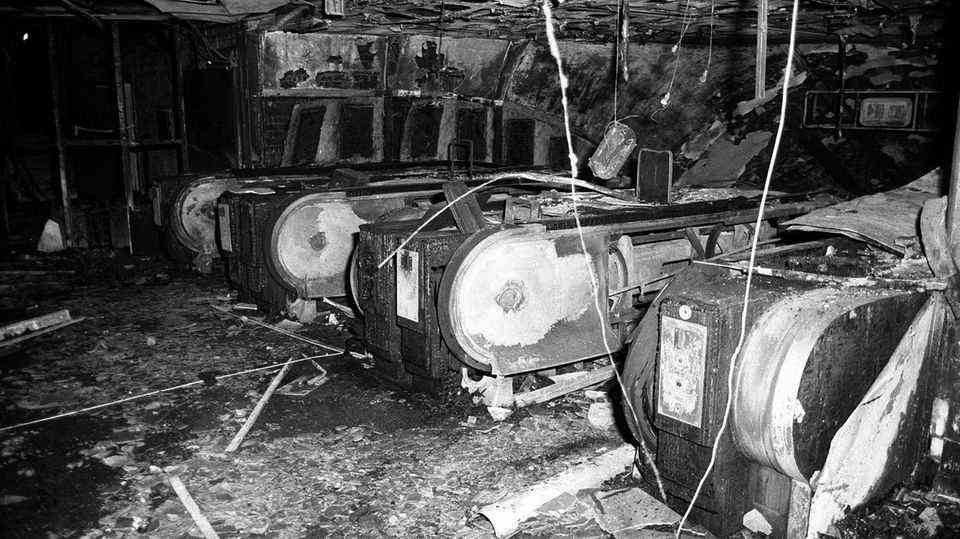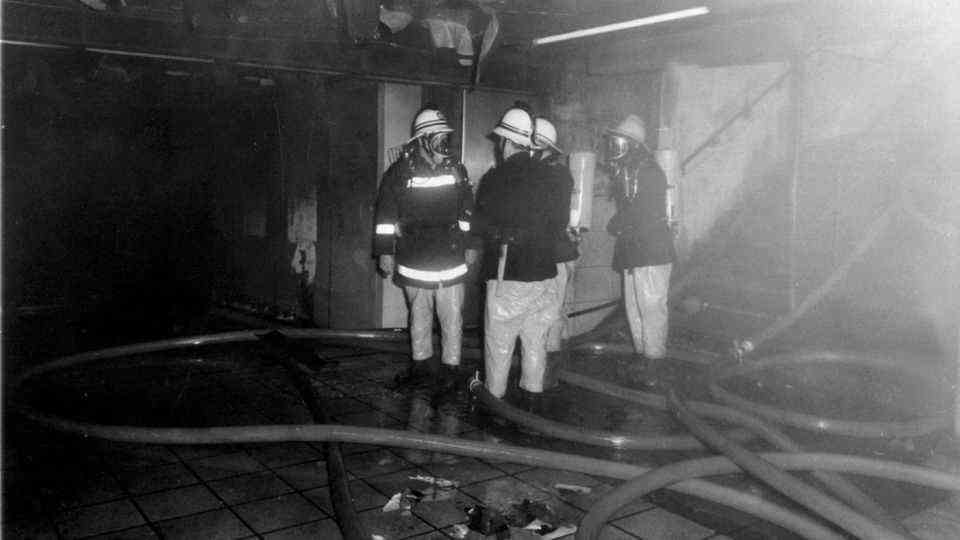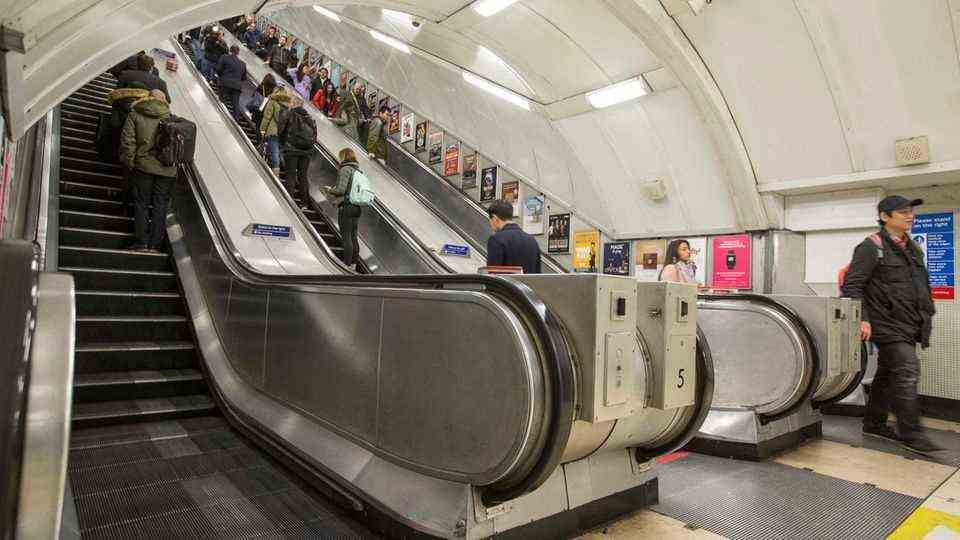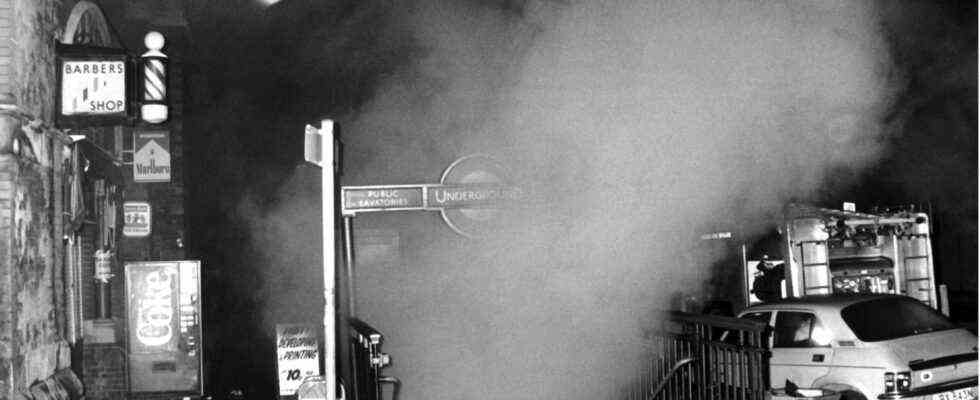34 years ago today
The day a fire in King’s Cross London Underground Station killed 31 people
Thick smoke pours from King’s Cross tube station in London on the evening of November 18, 1987
© London Express / Picture Alliance
On November 18, 1987, a disaster struck King’s Cross underground station in London. A fire breaks out on one of the wooden escalators. And the flames shoot up like a ball of fire into the counter hall filled with people.
It’s Wednesday evening and London’s main hub, King’s Cross Tube Station, is bustling with activity. The station below the main train stations King’s Cross and St. Pancras was then the only one served by five lines. Hundreds of people are in the train station complex. Around 30,000 people per hour pass through King’s Cross during rush hour. At 7.45 p.m. that evening, one of the worst disasters of the history of the London Underground took place here.
A passenger standing on one of the wooden escalators observes a flickering light between the steps. When he reached the counter at the top, he spoke to a train employee to tell him about it. But when he looks down, he can’t see anything. “I felt pretty stupid,” said the man in a documentary on National Geographic, “because there was nothing to see.”
At 7.40 p.m., King’s Cross station in London is evacuated
At around 7.30 p.m., another man presses the emergency stop button for the escalator to the Piccadilly Line. A British Transport Police officer investigating the incident discovered a small flame on one of the wooden steps. No big surprise for the man: in the last three decades there have been more than 400 fires in the outdated London Underground. He alerts the fire brigade by radio. The escalator will be cordoned off further down. At around 7.40 p.m. the police decided to evacuate the station.

The picture shows the top of the fire-damaged escalators in King’s Cross Underground Station
© dpa / empics / Picture Alliance
The emergency services are on site just three minutes later. The fire is now as big as a campfire, which is why the firefighters believe they can get it under control quickly. Hundreds of passengers are now being led out of the station by police officers, some of them using the Victoria Line’s only functioning escalator, which runs parallel to the Piccadilly Line’s escalator and leads to the same place upstairs in the ticket hall. However, because nobody informs the train control about the evacuation, more and more passengers get into the station.
The fire was not extinguished until 1:46 a.m.
Then suddenly the previously small fire turns into an inferno. Flames shoot up the escalator like a flamethrower. They travel twelve meters per second and capture dozens of people in the counter hall. From the exit thick smoke penetrates the higher street. Where a moment ago police officers sent passengers up the only functioning escalator, they are now stopping the incoming trains. At the top, firefighters who had just stormed into the station stagger back outside because heat and flames were blocking their way. Some passengers flee in a panic to the toilets, others crawl on the floor to the stairs that lead up to the street. But because of the heat and the acrid, thick smoke, many have no chance of escaping. The devastating fire was not finally extinguished until 1:46 a.m. the next morning.

Firefighters are standing after the extinguishing work in King’s Cross underground station in London: the ceiling has partially collapsed, the tiles have cracked from the walls
© PA / Picture Alliance
31 people are killed in the serious accident and another 20 are seriously injured. The youngest victim is seven years old. After the accident, the underground station was completely destroyed: the ceiling partially collapsed, the tiles cracked from the walls and the metal ticket machines melted.
The cause of the fire was possibly a burning match
Investigations later reveal that a burning match may have set fire to large accumulations of a mixture of rubbish and grease below the escalator. A smoking ban at subway stations had already been issued two years earlier. There are also traces on the 50-year-old escalator, which indicate that there have been 18 undiscovered smaller fires in the past.

The wooden escalators at King’s Cross were replaced with metal ones shortly after the fire
© Rick Findler / Picture Alliance
In order to find out exactly how the flames could spread so quickly, a few months later an exact model of the escalator is recreated in a field using the same materials and ignited. It turns out that the 30 degree incline of the stairs causes the flames to settle on the steps. The side walls of the escalator act like a channel that bundles heat and flames and prevents them from escaping. The fire pushes an invisible wall of heat and gas in front of it, which heats a meter-long section of the wooden steps from below, which ignites suddenly. The investigators call the phenomenon the “trench effect”.
As a consequence of the accident, among other things, the replacement of all wooden escalators and stricter monitoring of the smoking ban is ordered.
Sources: DPA, National Geographic


